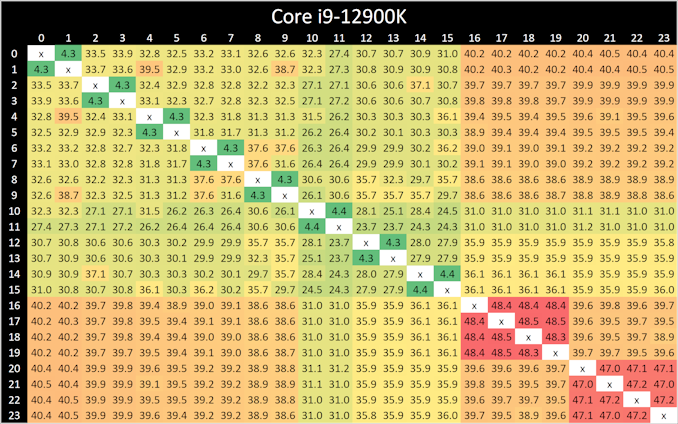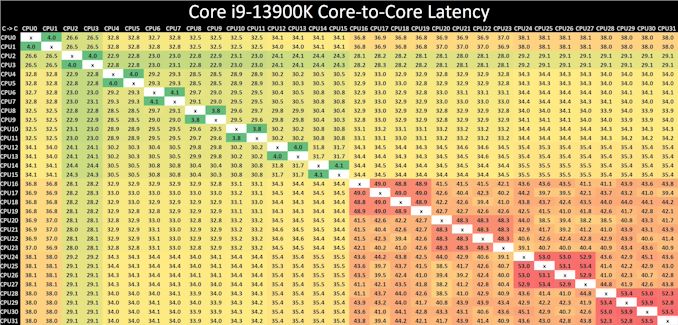Intel Core i9-13900K and i5-13600K Review: Raptor Lake Brings More Bite
by Gavin Bonshor on October 20, 2022 9:00 AM ESTCore-to-Core Latency
As the core count of modern CPUs is growing, we are reaching a time when the time to access each core from a different core is no longer a constant. Even before the advent of heterogeneous SoC designs, processors built on large rings or meshes can have different latencies to access the nearest core compared to the furthest core. This rings true especially in multi-socket server environments.
But modern CPUs, even desktop and consumer CPUs, can have variable access latency to get to another core. For example, in the first generation Threadripper CPUs, we had four chips on the package, each with 8 threads, and each with a different core-to-core latency depending on if it was on-die or off-die. This gets more complex with products like Lakefield, which has two different communication buses depending on which core is talking to which.
If you are a regular reader of AnandTech’s CPU reviews, you will recognize our Core-to-Core latency test. It’s a great way to show exactly how groups of cores are laid out on the silicon. This is a custom in-house test, and we know there are competing tests out there, but we feel ours is the most accurate to how quick an access between two cores can happen.

Looking at core-to-core latencies going from Alder Lake (12th Gen) to Raptor Lake (13th Gen), things look quite similar on the surface. The P-cores are listed within Windows 11 from cores 0 to 15, and in comparison to Alder Lake, latencies are much the same as what we saw when we reviewed the Core i9-12900K last year. The same comments apply here as with the Core i9-12900K, as we again see more of a bi-directional cache coherence.
Latencies between each Raptor Cove core have actually improved when compared to the Golden Cove cores on Alder Lake from 4.3/4.4 ns, down to 3.8/4.1 ns per each L1 access point.
The biggest difference is the doubling of the E-cores (Gracemont) on the Core i9-13900K, which as a consequence, adds more paths and crossovers. These paths do come with a harsher latency penalty than we saw with the Core i9-12900K, with latencies around the E-cores ranging from 48 to 54 ns within four core jumps between them; this is actually slower than it was on Alder Lake.
One possible reason for the negative latency is the 200 MHz reduction in base frequency on the Gracemont cores on Raptor Lake when compared with Alder Lake. When each E-core (Gracemont) core is communicating with each other, they travel through the L2 cache clusters via the L3 cache ring and back again, which does seem quite an inefficient way to go.











169 Comments
View All Comments
WannaBeOCer - Friday, October 21, 2022 - link
Did you even read the article? Intel advertises the 13900k as a 253w chip. It drew 32% more than it advertised while AMD advertises its 7950x as a 170w and it drew 30% more than they advertised.“Processor Base Power
125 W
Maximum Turbo Power
253 W” Reply
Wrs - Friday, October 21, 2022 - link
You're comparing the PL2 of one chip with the TDP of the other. Also, the article mentioned the motherboard may have something to do with ignoring the PL2 on the 13900k.If the chip can't dissipate PL2, it'll incrementally step down to TDP gracefully. It's like you're complaining your 130mph sedan went 165mph on the race track... Reply
Gastec - Sunday, October 23, 2022 - link
Oh, so the motherboards are the culprits for overclocking the CPU's to new height of financial success, not Intel? ReplyWhatYaWant - Thursday, October 20, 2022 - link
7600x seems a bit overpriced, doesn’t it? Replyingwe - Thursday, October 20, 2022 - link
Yeah it does. $250 seems like a better price--maybe even a bit lower. It will probably come down. I just picked up a 5600 for $125 though so I am set. I suspect that the price will only come down on the 7600x once the stock of 5 series is cleared out. Replymeacupla - Thursday, October 20, 2022 - link
I am happy that Raptor Lake offers stiff competition to Zen 4. Hopefully AMD brings down the price of 7600X, and hurry up and launch their B650 boards Replycaqde - Thursday, October 20, 2022 - link
?? B650 is released? At least on Newegg and amazon you can purchase a selection of B650 motherboards today. Out of the 23 boards listed, 1 is out of stock and 5 are preoders for the 21st or 27th. So that leaves 17 boards that you can purchase today that are in stock, the in stock boards go from 170-350 (Asrock 650M PG Riptide and Gigabyte B650E Aorus Master respectively). But yeah AMD should and from what I have heard can lower Zen 4 prices to compete with Intel's prices. Replyhaukionkannel - Thursday, October 20, 2022 - link
When AMD release 3d cache versions, it will reduce the prices of normal versions.How much, is interesting question. I expect that AMD also will release 7600 to compete with intel in price, so 7600x may not come down a lot. Reply
meacupla - Thursday, October 20, 2022 - link
Oh, B650 is out already? I saw no news coverage of them, so I thought they were still waiting to be released. Replytechguymaxc - Thursday, October 20, 2022 - link
You list Handbrake under legacy tests however, either the graphs or mislabeled or the tests are not included. Did you test these CPUs with Handbrake? If so, please post the results. If not, please consider testing and updating the article. This is the only workload that matters to me, and the number one reason I come to Anandtech for CPU reviews/benchmarks. Reply